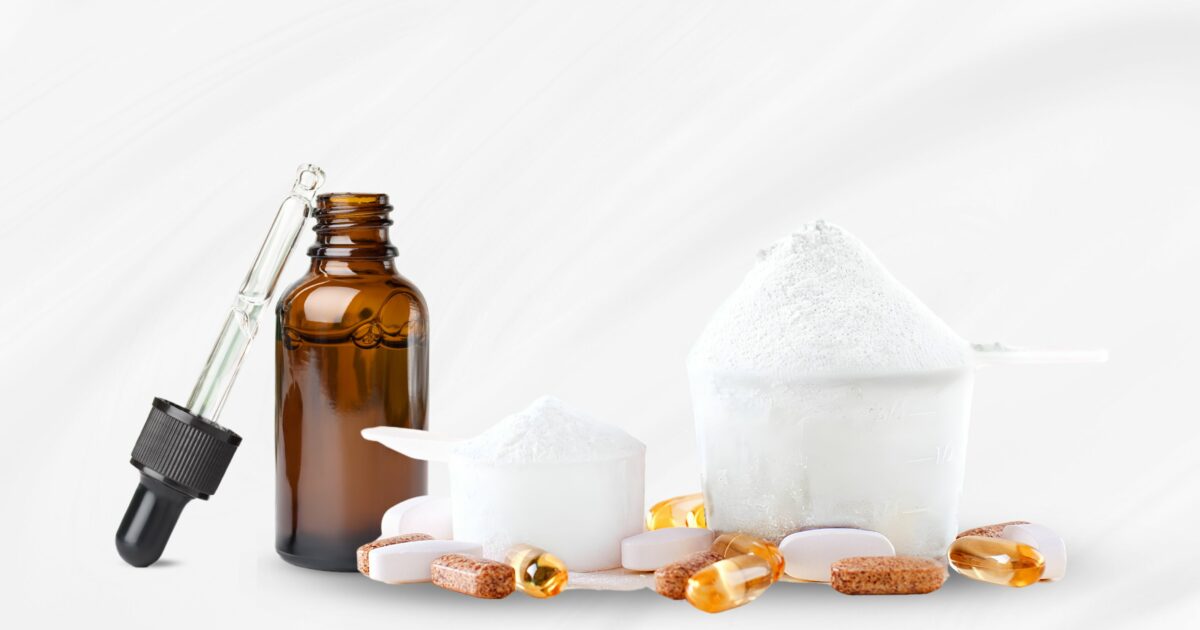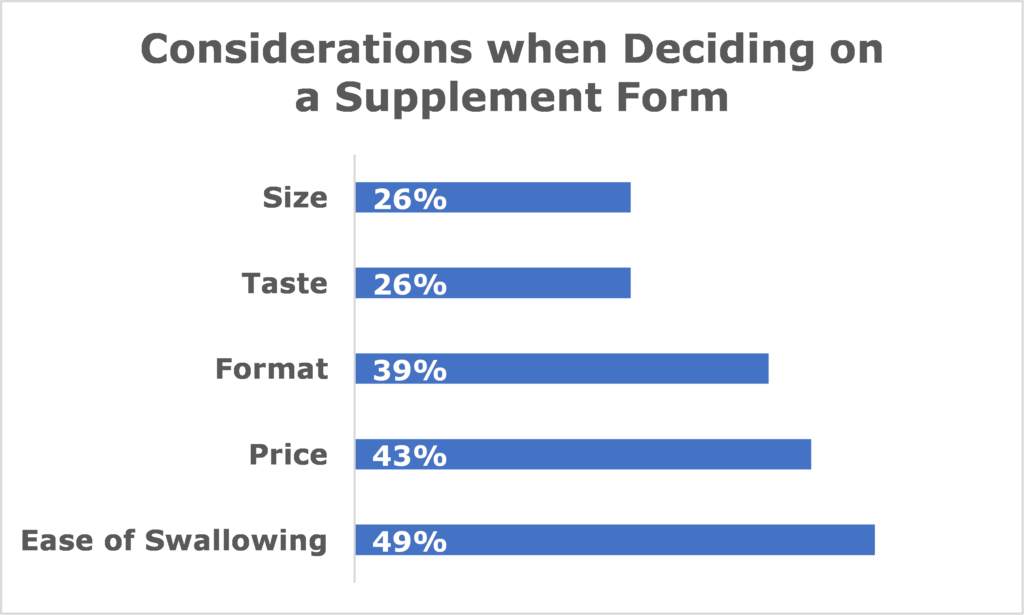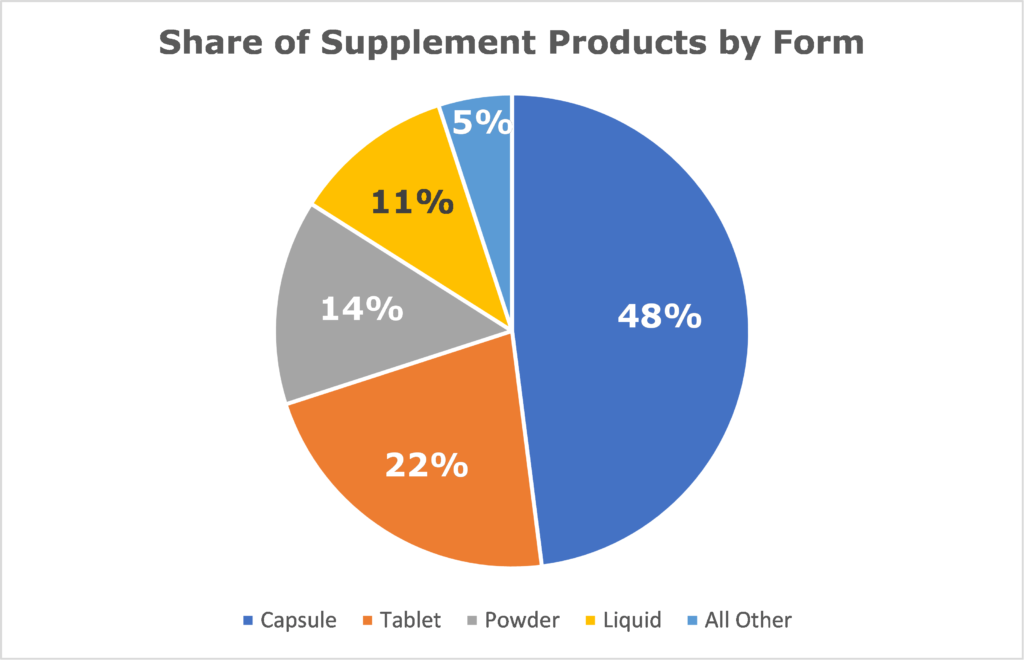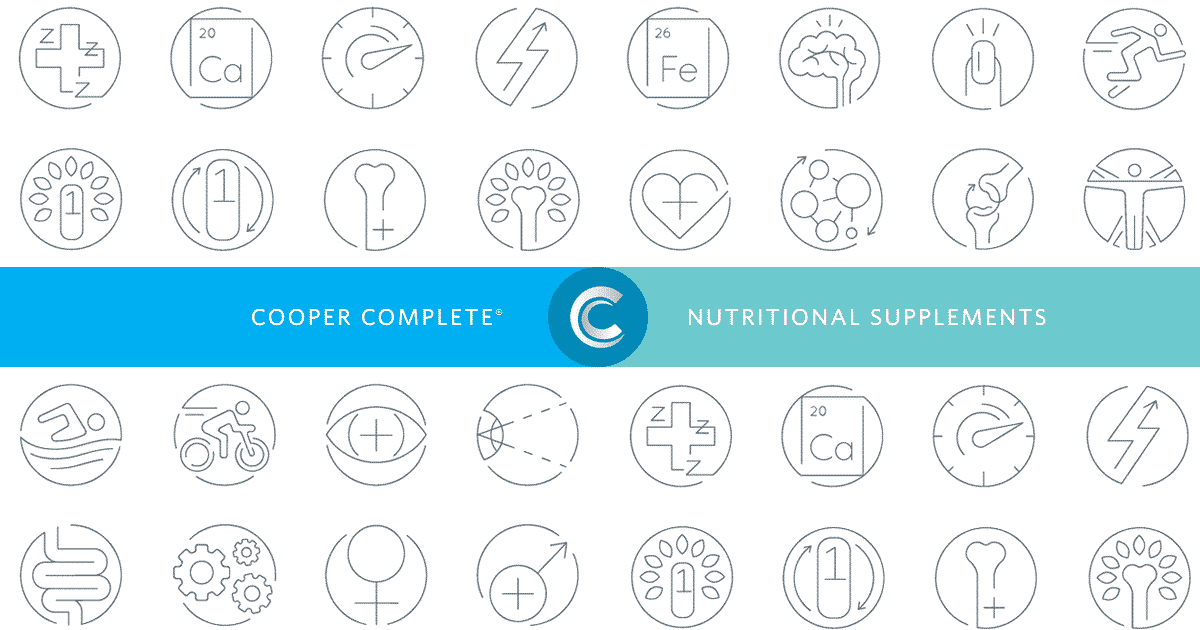Supplement Forms: Is One Type of Pill Better Than Another?

Vitamins and nutritional supplements come in several distinct forms from tablets, capsules and softgels to gummies, liquids and powders. While marketers often use supplement form to differentiate and make the product more appealing to consumers in their advertising, form is actually driven by a number of important factors.
The form in which a supplement is manufactured is primarily determined by the active ingredients themselves, as well as the systems in the body receiving their benefits. Considerations may include:
- Bioavailability of the active ingredient absorbed by the body
- Gastrointestinal resistance
- Release time
- Stability
- Uniformity
- Consumer experience and preference
While consumer preference may not be the most influential consideration to the manufacturer, it’s everything to the individual who takes supplements on a daily basis. Nearly half of all consumers surveyed by the Council for Responsible Nutrition (CRN) cited ease of swallowing as their top decision criterion. And, other than price, every other primary criterion is an integral part of the consumer experience, including supplement form, taste and size.

Following are descriptions of each oral supplement form, followed by a table outlining the pros and cons of each.
Capsules
One of the most prevalent oral supplement forms, capsules use a smooth, hard casing to enclose active ingredients in powder or liquid form. Traditionally, gelatin capsules were made exclusively from bovine or porcine skin and bones. In recent years, technology has made it possible to create capsules from fish, chicken and even vegetable cellulose. If the front label of the bottle front doesn’t specify the capsule’s form, the supplement is typically made of animal-based material. However, the list of “other ingredients” featured directly below the supplement facts states the capsule’s ingredients.
The capsule prevents external liquids or oil-based ingredients from seeping into the internal active ingredients. A drawback to capsules is they have major space issues and ingredients can’t be compressed or concentrated. (Due to space limitations, many multivitamins are manufactured as tablets rather than capsules.)
Examples of how capsules are described in the label’s “other ingredients” include:
Capsule Composition |
|
|---|---|
| Capsule Types | Most Common Source |
| Capsule | Bovine |
| Fish Capsule | Tilapia |
| Vegetarian Capsule | Hypromellose cellulose Hydroxypropyl cellulose or Microcrystalline cellulose |
Tablets
Another very common supplement form, tablets are hard pills produced by compressing active ingredients that originate in powder or granular form—with other ingredients called excipients to help bind and solidify the tablet. Compared to capsules and softgels, tablets typically feature higher concentrations of active ingredients due to their compression manufacturing process. Unless the label says otherwise, it is safe to crush or cut the tablet into smaller pieces, as necessary.
Time-Release Capsules and Tablets
Also referred to as sustained-, extended- or prolonged-release supplements, time-release capsules and tablets are manufactured as described above. The active ingredients in time-release supplements are embedded in a micro-encapsulation that releases slowly, dissolving little by little over time. Rather than delivering active ingredients all at once, they’re spread out over a period that usually lasts six to eight hours. Extended-release supplements should not be crushed, split or chewed. Additionally, avoid damaging the seal of the capsule or tablet, as it will disrupt the timed delivery of the product.
Softgels
Similar to gelcaps, softgels are gelatin shells that contain a liquid form of active ingredient. While the most common gelatin is sourced from animals, it’s softgels are also made from fish and vegetable cellulose. The softgel shell is typically softer and more flexible than the hard gelatin capsule on gelcaps, making them more suitable for smaller doses. Softgel shell material is antioxidant, protecting contents against UV rays and oxidation. The material is also the first choice for oils and other liquid ingredients, extending their shelf life more than bottled liquids which are exposed to oxidation each time the container is opened.
Softgels hermetically seal contents to protect ingredients from air and are often colorized and opaque to help further protect against light and UV rays. The manufacturing process of a softgel is complex in both science and craft as there are different levels of softgel thickness and hardness. Temperature and humidity can greatly affect the manufacturing process and the time and care needed to fully dry the softgel exterior.
Gummies and Chewable Tablets
Gummies were introduced in the mid-1990s to promote supplementation to consumers averse to taking pills, including children and people with swallowing difficulties. Sugar (in every form) and sugar substitutes along with flavorings are added to the vitamin, mineral, or herb to create a palatable taste. However, this typically comes at the expense of the number of nutrients included. Simply put, raw vitamin ingredients are generally not pleasurable without flavoring. And as minerals all come from the earth it can be difficult to mask dusty, chalky, and metallic tastes.
Sweeteners (every form of sugar and sugar substitute) and other ingredients that make gummies taste good unfortunately come at the expense of the number and concentrations of active ingredients, with gummy supplements typically offering fewer nutrients in lower concentrations. The active ingredients in gummy supplements absorb into the body as well as other forms, but there are fewer of them.
Below is a comparison of Cooper Complete and Centrum® multivitamins in tablet and gummy form, illustrating the differences in several active ingredient concentrations.
Multivitamin Ingredient Concentrations |
|||
|---|---|---|---|
| Ingredient | Cooper Complete Basic One Tablet | Centrum Adults Tablet | Centrum Adults Gummy |
| Vitamin B12 | 400 mcg | 6 mcg | |
| Vitamin C | 150 mg | 60 mg | 30 mg |
| Vitamin D3 | 50 mcg (2000 IU) |
20 mcg (1000 IU) |
20 mcg (1000 IU) |
| Magnesium | 200 mg | 50 mg | |
| Zinc | 15 mg | 11 mg | 5 mg |
Liquids
The active ingredients in liquid supplements occur either naturally as liquids or are suspended in water, oil-based, or alcohol-based liquids as carriers for consumption. Liquid supplement forms are considered to have high bioavailability—absorption of the active ingredient into the body. A study on vitamin D bioavailability shows, however, that the type of liquid carrier may affect bioavailability, with oil-based carriers delivering the highest vitamin D levels to the bloodstream. The shelf life of liquid products is typically shorter than that of other supplement forms. Normally, after opening a bottle it must be used quickly.
Powders
The third most prevalent supplement form, powder supplements are a dehydrated form of active ingredients that are dissolved in water or other liquid for consumption. Protein powders, collagen, and fiber are examples of popular powdered supplements. Because the active ingredient is disintegrated before consumption, powders are considered more easily absorbed into the system. The serving size of powder supplements is easily adjusted, delivering higher or lower servings as needed.
Summarized below are the primary advantages and disadvantages of each oral supplement form.
Supplement Form Pros and Cons |
||
|---|---|---|
| Supplement Forms | Pros | Cons |
| Capsules |
|
|
| Tablets |
|
|
| Time Release Tablets and Capsules |
|
|
| Softgels |
|
|
| Liquid |
|
|
| Powder |
|
|
In terms of the prevalence of each supplement form, the National Institutes of Health’s (NIH) Dietary Supplement Label Database shows almost half of all dietary supplement products are sold in capsule form (which by definition includes gel caps and softgels).

“All Other” includes gummies at 0.8% of supplements in the U.S. market.
Which Form is Right for You?
When deciding which form of oral supplement you should take, consider the active ingredient first. Whether you’ve learned you have a specific vitamin deficiency, are following your physician’s instructions, or simply know what nutrients make you feel best, identify the nutrients you need to supplement. Once you know what nutrients you need, you can choose an available form you’ll be comfortable taking every day, ensuring to get an adequate dose of each.
Taking supplements consistently over time is essential to the sustained, long-term benefits they deliver. A study conducted by The Cooper Institute on the effects of vitamins and nutritional supplements on CRP levels in the body—a marker for systemic inflammation—also quantified their effect on vitamin levels in the bloodstream. After six months of supplementation with Cooper Complete Original Comprehensive Multivitamin—a 24-ingredient multivitamin/mineral formula in tablet form—plasma vitamin levels were increased significantly, as shown below.
Plasma Vitamin Levels |
|
|---|---|
| Vitamin | Percentage Increase |
| Folic Acid | 47% |
| Beta Carotene | 51% |
| Vitamin B12 | 55% |
| Vitamin C | 69% |
| Vitamin E | 97% |
| Vitamin B6 | 272% |
Your health care provider is most familiar with your specific health status and the nutrient levels in your system. Consult your physician about recommended forms of oral supplementation before adding any new supplement to your daily regimen.
For your reference, the table below lists all Cooper Complete Nutritional Supplements and the forms in which they are available.
Vitamin B12 Methylcobalamin 1000 mcg
Cooper Complete Nutritional Supplements |
||
|---|---|---|
| Supplement Form | Product | |
| Capsules | Advanced B Complex Advanced Probiotic Ashwagandha Berberine Complex CoQ10 100 mg Joint Health L-lysine Supplement 1500 mg Magnesium Glycinate Menopause Health Plant Sterols Potassium Chelate 99 mg Prostate Health Quercetin Complex Turmeric Curcumin Complex Vitamin B12 (Methylcobalamin) Supplement |
|
| Tablets | Basic One Multivitamin (with and without iron) Calcium Citrate Iron Bisglycinate Methyl Folate 5000 mcg (5 mg) Quick Release Melatonin Original Comprehensive Multivitamin (with and without iron) Natural Vitamin C Zinc Supplement 30 mg |
|
| Time Release Tablets | Prolonged Release Melatonin | |
| Softgels | Advanced Omega-3 CoQ10 50 mg Eye Health Vitamin D3 25 mcg (1000 IU) Vitamin D3 125 mcg (5000 IU) |
|
| Liquid | Advanced Omega-3 Liquid Vitamin D3 25 mcg (1000 IU) Liquid Drops |
|
| Powder | Collagen Complex Microbiome Fiber |
|
